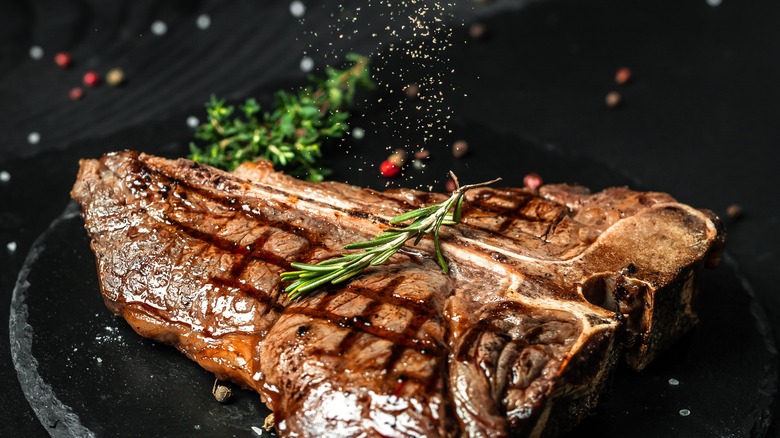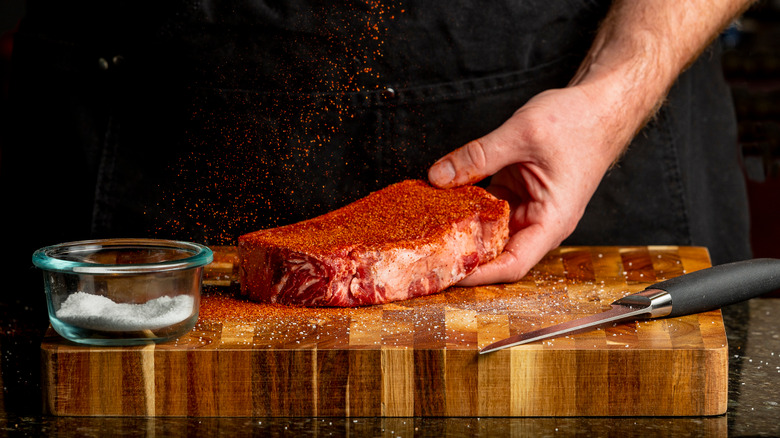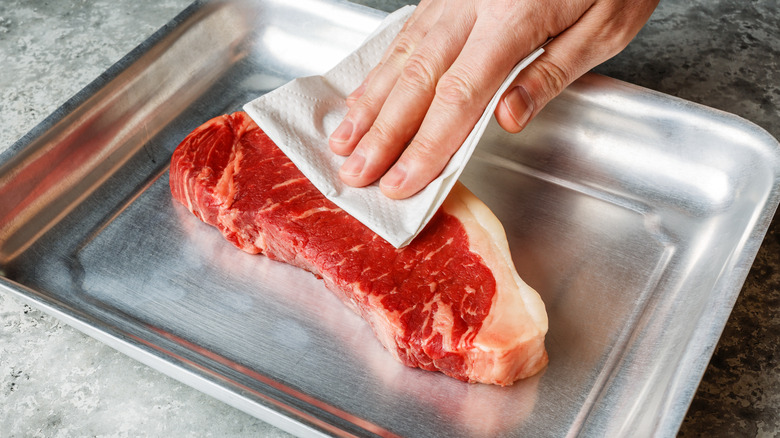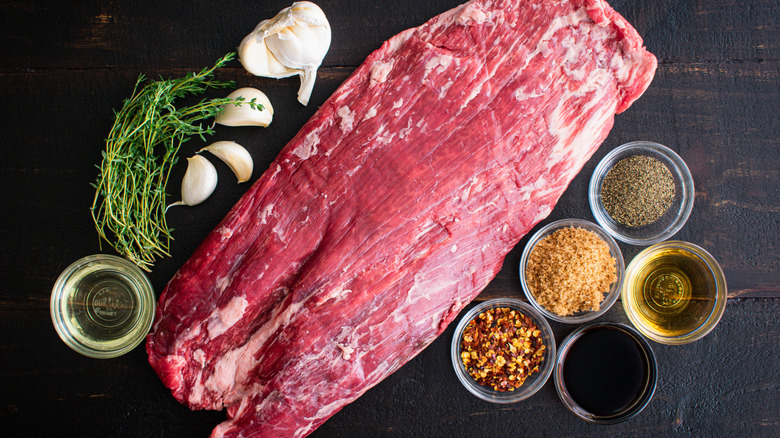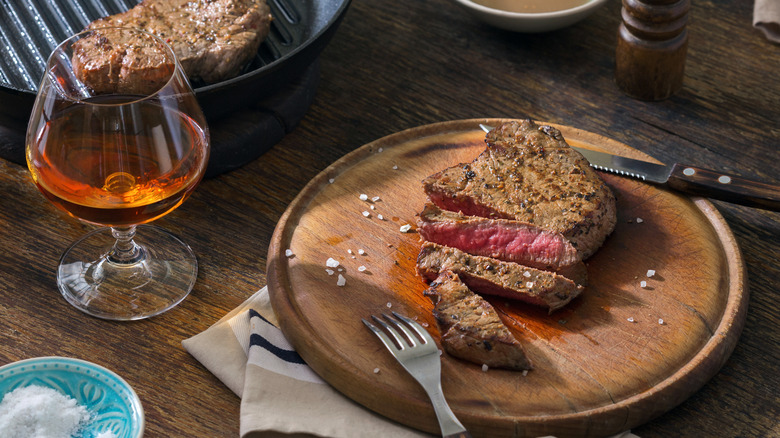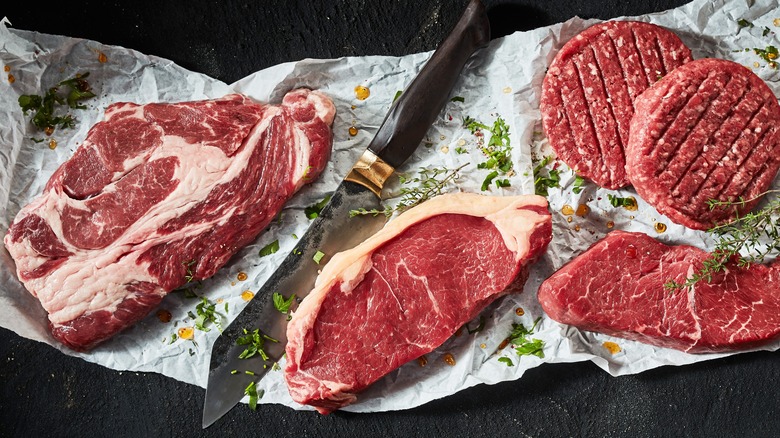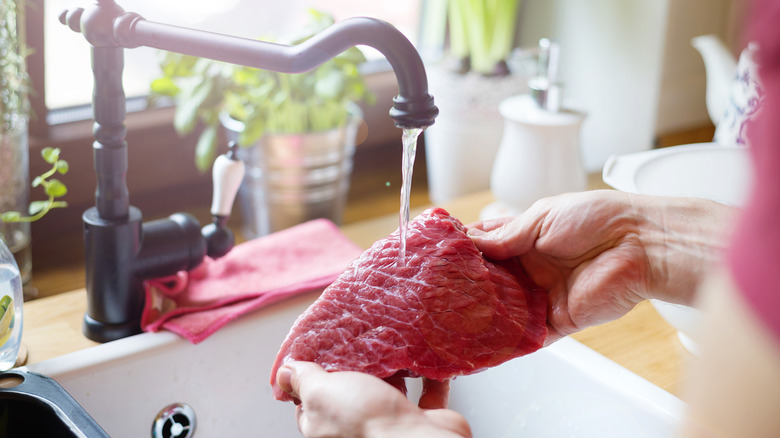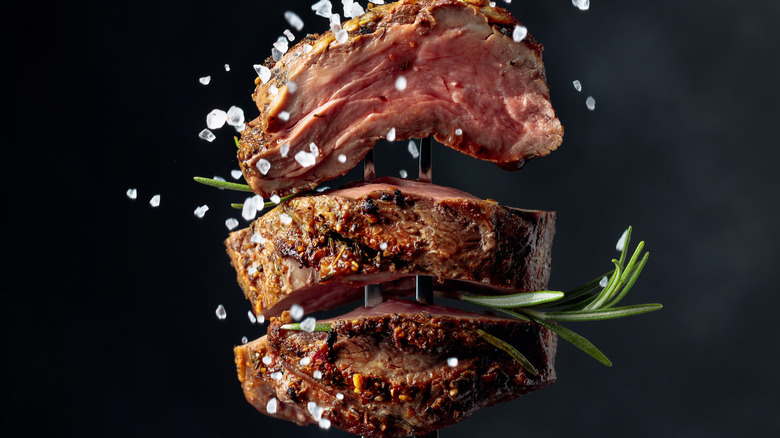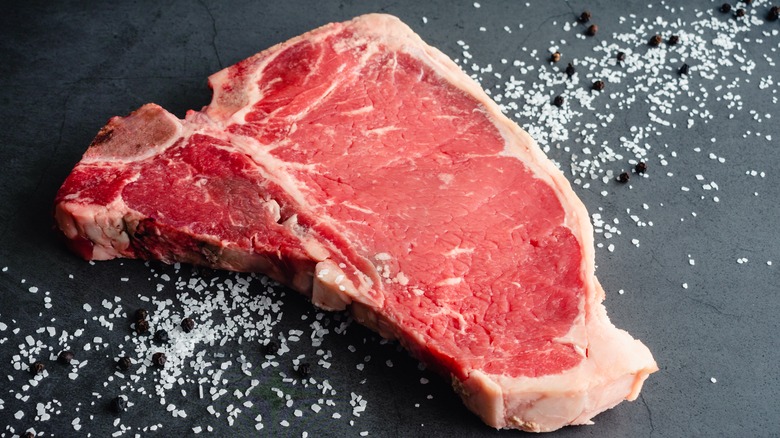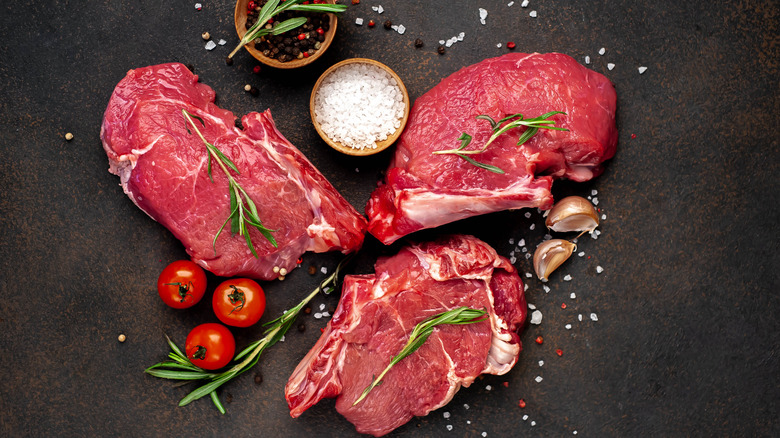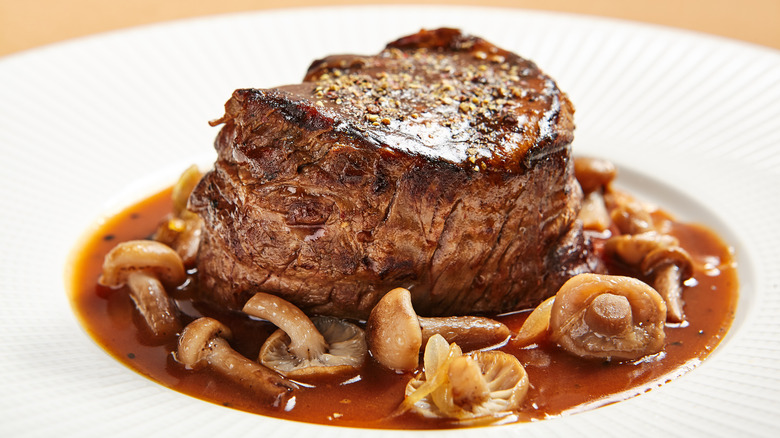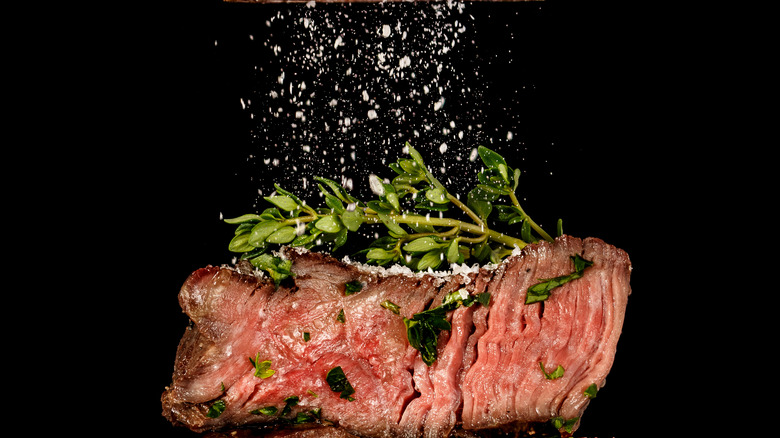Common Mistakes You're Making When Seasoning Steak
There's nothing quite like a thick, juicy steak, and, according to one survey, Americans know it: A poll conducted by The Linz Shop found that almost 2 out of every 3 Americans would choose steak as their last meal. The results also showed that steak is the type of meat that most people like to grill at home. However, because of the vast popularity of this delicious meal, it's important for home cooks to know how to prepare it correctly.
The good news is that cooking steak doesn't have to be difficult. Chef German Rizzo of Plado Tasting Bar told The Independent that you can prepare an excellent steak by following a few simple steps: The chef explained that the steak just needs to be grilled and seasoned with salt and pepper.
Unfortunately, though, many amateur chefs struggle to take Rizzo's advice. After all, not everyone knows how to season a slab of meat properly. According to Chef Makoto Ono, seasoning is primarily what differentiates home cooks from chefs (via The Globe and Mail).
Luckily, you don't have to go to culinary school to prepare restaurant-quality steaks at home. By adding a couple of tried and true techniques to your cooking routine, you can learn to season steak like a pro.
You don't use a dry rub on your steak
Many home cooks think that adding seasoning is the final step of the cooking process. However, when it comes to preparing steak, the best move is to season your meat a few minutes before it hits the heat. One way to do this is by using a dry rub, which is just a mixture of spices that you can spread across any type of raw meat (as per Bon Appétit). Most dry rubs consist of salt and pepper, although some chefs like to include stronger spices, like paprika or cayenne.
Regardless of the steak seasoning you choose, however, it's important to keep in mind that dry rubs should include no water-based ingredients. According to meat scientist Charlie Knote, the reason is that moisture can actually interfere with your steak's cooking process (via Tampa Bay Times). Browning wet meat can be quite difficult.
Because of this, when seasoning steak, you should opt for a dry rub over a marinade. Simply dab a tiny amount of olive oil on your steak, and spread your dry rub across the meat's surface. The best part is that you don't have to wait for your steak to absorb the flavor. As "Master Chef" host Marcus Wareing wrote in his book "Marcus Everyday," it's essential to season the meat before cooking it in the pan (via Daily Record).
You forget to pat down your steak dry
If you are in the mood for a juicy steak, you probably don't want to dry your meat out. You might even avoid patting down your steak before seasoning it. In the end, wouldn't that just dry out your meat? Well, according to professional chefs, this mentality could lead to a massive culinary mistake. According to Chef Joe Cervantez of Pier 6, patting down the meat will ensure an ideal crust (via Food & Wine).
The explanation for this tip boils down to a scientific concept called the Maillard reaction. According to the Science of Cooking, the Maillard reaction is a reaction that takes place when heat is applied to amino acids and sugar. This process makes the outside of your steak turn brown and crunchy after putting it on the grill. Unfortunately, an excess of water on your steak's surface can prevent this reaction from occurring properly, leaving you with a squishy result.
To achieve a crunchy crust full of delicious spices, you should pat your steak dry prior to adding the dry rub. Just grab a paper towel and press it against the surface of the meat until it absorbs all of the excess water. Don't be afraid to dry your steak too much. The less moisture that exists on the meat's surface, the more delicious it will be after cooking it.
You don't add sugar to your dry rub
Sugar might seem like it belongs in a chocolate cake rather than on a slab of red meat. Nonetheless, when it comes to seasoning steak, this sweetener is a powerful secret ingredient. In an interview with Lick My Spoon, one anonymous amateur cook shared his trick for making the perfect dry rub at home: The trick to making the perfect rub is ensuring that the rub does not contain too much salt. It should have a mix of brown sugar as well as black and white pepper, all of which help balance out the flavors.
Interestingly, there might very well be a method to his madness. Science shows that adding a sweetener to your dry rub can actually result in a higher-quality steak (via Online Grill). As noted by Niman Ranch, sugar will give your meat a wonderful crust that tastes quite delicious. In other words, adding sugar to your steak seasoning can actually help the Maillard reaction along. Ultimately, this will improve both the texture and the color of your meat.
To put this concept into practice, try making this simple three-ingredient dry rub recipe. Simply combine garlic salt, paprika, and brown sugar. Then, add the final product to your steak or even to your sides. You might just find that your steak ends up with a restaurant-quality crust.
You ruin the seasoning by adding high-proof whiskey
It's not uncommon to wash down a delicious steak with a nice glass of whiskey. As noted by Mac's Chophouse, many steak connoisseurs find that whiskey's smokey flavors pair well with a slab of beef. Because of this, some home chefs may be tempted to grab a bottle of their favorite whiskey and use it to marinade their steak. They might even add the spirit to their wet rub seasoning, hoping that their meat will absorb its smokey flavors.
While this move might be well-intentioned, it could actually ruin your meal. The reason is that substances with a high alcohol content can impact the way that your steak interacts with heat during the cooking process. As Chef Whitney Fontaine told Liquor.com, alcohol can often make fats thicker. This means that cooking with a higher-proof whiskey could make your steak tough and chewy (via Love Food Love Science).
The good news is that you can incorporate whiskey into your steak dinner without compromising the quality of the steak. However, this means keeping the booze far away from your seasoning. Instead, try serving your steak on a bed of risotto. As Fontaine explained, this delicious rice dish can actually be improved by adding a dollop of bourbon to the recipe. Whiskey can also be used to enhance the flavor of various varieties of breads, pilafs, and fruit cups.
You've never tried a dry brine
If you are tired of always using a dry rub, you might consider spicing things up by trying a dry brine. Unlike a dry rub, which is added to the meat directly before hitting the fire, a dry brine is applied to the steak hours or even days before cooking (per Cinder). To try out this method, start by seasoning your steak with a generous portion of salt.
Then, place the meat in the fridge. While it rests, the meat's internal juices will rise to the surface and mix with the salt to create a juicy brine. The resulting solution will then be reabsorbed back into your meat, leaving you with a succulent final product.
While this technique can produce outstanding results, not everyone agrees on the ideal amount of time to brine your steak. For Australian private chef, Zac Sykes, the best method is to leave your steak in the refrigerator for days at a time. As he told the Steak School, an effective technique is to salt the meat and dry it in the fridge for a few days to a week.
Meanwhile, American home cook, Chase Larson, prefers to brine his steak for a shorter period of time. He recommends laying the steak on the fridge for 24 hours, which is called the overnight dry brine method.
You don't rinse off your dry brine
Dry brines can add a juicy texture to your steak, but they shouldn't remain on your meat forever. On the contrary, you should head to the sink and rinse the dry brine off of your steak before you put the meat on the fire (via Just Cook with Sally). As you clean your meat, try to remove almost all of the salt from its exterior. Otherwise, the final product could taste so salty that its taste would no longer be enjoyable.
For some home chefs, salting and subsequently rinsing a steak might seem like a waste of time. After all, it could feel pointless to add a generous amount of salt to the meat only to remove it shortly after. However, the reason that dry brines work so well isn't because of the salt's flavor but rather its chemical properties.
The salt in a dry brine takes part in a chemical process that impacts the protein in your meat. As a result, these proteins are more able to carry the meat's juices, leaving you with a more succulent result.
While salt does a great job of making your steak juicy, the flavor that it leaves on the crust can be overpowering. If you realize that you have added too much salt to your steak, don't fret. As chef Raymond Southern told Food & Wine, just rinse it off in hot water.
You season your steak with overpowering flavors
Spices are important, but they are far from being the main meal. As a result, your steak seasoning should not be so strong that it overpowers the meat's naturally-rich flavors. Dry rubs with high concentrations of hot pepper, for example, can be so fiery that they distract from the rest of the plate. Likewise, combining too many spices into a single rub can result in a final product that's too overwhelming to simply enjoy.
If you are worried that your dry rub routine is too overpowering, don't despair. There are plenty of strategies for making sure your seasoning actually enhances the flavor of your steak. One strategy is to make your own rub, using just three ingredients: Salt, pepper, and a unique spice of your choosing (via DiLuigi Foods). Alternatively, you can trust a tried and true rub recipe. For example, this smoky dry rub recipe gives your steak a more complex flavor without totally stealing the show.
Once you've selected a nice, subtle dry rub, you might be tempted to spread it across your steak with gusto. Instead, avoid adding so much seasoning to your steak that the flesh of the meat disappears from view. As noted by Smoker Grill Girl, if your rub starts to look "clumpy" or "crusty," that's a fair sign that you need to tone things down. For the best results, D'Artagnan suggests adding one tablespoon of dry rub for every pound of meat.
You don't use kosher salt in your seasoning
Most dry rub recipes call for salt, and, at first glance, it might not seem that there's anything special about this ingredient. However, using kosher salt, as opposed to table salt, can make a huge difference when it comes to creating the perfect steak seasoning. According to food stylist Katie Stilo, the perfect steak begins with seasoning (via Today)
For her, this means adding a ton of salt to your meat, although Stilo doesn't recommend using just any old salt. He suggests that cooks use kosher salt. The reason that kosher salt is so appealing pertains largely to its refining process. While table salt is the most refined type of salt, the kosher alternative has only undergone a moderate amount of processing.
As a result, kosher salt tends to come in larger, thicker pieces that aren't as dense as grains of table salt. This makes it easier for cooks to add it to a raw steak with more accurate portion sizes (via Napoleon).
Additionally, according to A Couple Cooks, table salt tends to contain iodine, which can inadvertently contaminate your meal's flavor with a bit of unexpected bitterness. In that sense, choosing kosher salt gives your creation a better flavor.
You season chuck as if it were tenderloin
Steaks come in many different cuts, and each one requires its own unique preparation process. Each cut of meat varies considerably in terms of muscle quality, which, in turn, impacts the overall texture and flavor of your steak. According to chef Daniel Holzman of The Meatball Shop, meat stems from muscles, and the more toned a muscle is, the more flavors it tends to contain (via Taste). Muscles like the tenderloin, which are not as frequently used, tend to be rather bland.
Because of this difference, tougher cuts, like beef cheeks or chuck, need to be salted well before cooking. This gives those more affordable steaks time to become more tender before throwing them over the fire. To achieve the best results, Holzman recommends seasoning these steaks early on in the cooking process. He explains that seasoning the meat is essential for these cuts as it gives the salt time to infiltrate the pieces of meat.
Meanwhile, more expensive cuts like tenderloin don't need to be tenderized or soaked in a week-long brine. However, they still benefit from that amazing crust formed by the Maillard reaction. When it comes to these softer steaks, try adding a basic dry rub seasoning right before they hit the grill. This will also help them retain their juiciness without making them mushy.
You don't consider which sides you'll serve with the steak
Many home chefs believe that every steak deserves to be served alongside a delicious side. Nonetheless, not everyone remembers to pair the flavors from their seasoning with the rest of the meal. While this might seem like an innocuous mistake, it can actually have a huge impact on the overall perception of the food that you serve.
For example, if you serve a parsley-bathed steak with a side of garlic potatoes, you might find that the stronger flavor of the garlic completely overwhelms the softer taste of the parsley (via Homegrown Herb Garden). Ultimately, this seasoning error could detract attention from your perfectly-grilled steak.
To avoid this problem, you could prepare a tried-and-true flavor pairing, such as this teriyaki beef and asparagus combination: The sweetness of the teriyaki sauce will offset the bitterness of the asparagus without drowning out the taste of the meat.
Alternatively, you could prepare a steak with a dry rub consisting of salt, pepper, and paprika. Then, serve your meat with a side of this Mexican rice. In this combination, the soft yet spicy flavor of the paprika will accentuate the natural sweetness of the tomatoes and yellow onions in the rice.
You rely on seasoning to add flavor to a low-quality steak
At the end of the day, it doesn't matter how much seasoning you add to your steak: The quality of the final product depends on the quality of the meat. An old piece of meat will never taste fresh, and no amount of Kosher salt can change that. Because of this, try to buy the best steak that you can afford, not in terms of price but in terms of freshness.
According to chef Daniel Holzman, it's better to opt for a lower-priced cut from a butcher shop rather than an expensive cut from the grocery store (via Taste). When picking out a steak at the butcher, keep an eye out for telltale signs that the meat is fresh. Poke and prod the meat while it's cold to make sure that it feels firm to the touch (via Professional Secrets).
Also, check for "marbling," or the white and red patterns that appear on a steak's surface. Marbling can indicate whether or not a piece of meat contains fat: As Crowd Cow notes, fat content adds more flavor to your steak.
Last but not least, don't forget to rely on the experts. You can always chat a bit with your local butcher about their preferences. These conversations can help you select the right piece of meat for whatever purposes you have in mind.
